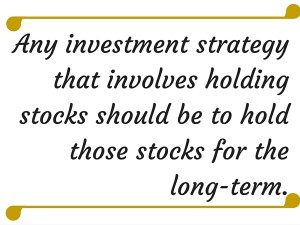Panic selling of stocks can be expensive for investors
February 11, 2016

The best solution to endure stock market volatility is to put those normal market fluctuations into perspective. That is the objective of today’s column.
This year stock markets got off to a rocky start.
Stocks in China fell 7 per cent, which pointed stock values around the world in a downward direction.
The American stock market as measured by the S&P 500 had its worst five-day start in its history.
To say that stock markets are unpredictable is an understatement.
An investment firm in the United States began their 2016 forecast by saying: “We have no idea.” To be fair, everyone in the investment business has no idea about the short-term results of the stock market; however, very few will admit it publicly.
Professor Jeremy Siegel’s book, Stocks for the Long Run, studied valuations of stock markets since the beginning of stock markets. His conclusion was that stocks are very predictable in the long term.
Predictability of stock markets in the short term has remained elusive. Those who attempt to outsmart the market generally fail and we have given the details of that in many past columns.
Barron’s had an interesting article “Bright Side to Stock Rout”, in their Jan. 19th edition. It had some interesting information that will allow many investors to put short-term stock market losses in proper context.
Referring back to 1926 the writer, John Kimelman, said: “In just about every year, the stock market experiences a significant downturn. Yet the long-term returns on stocks have been fantastic despite these periodic setbacks.”
If you had invested one dollar in the S&P 500 in 1926 that would be worth $5,386 at the end of 2015. That represents an annual return of about 10 per cent.
In every five-year period since 1926 returns have been positive 87 per cent of the time. Extend the holding period to 10 years and the results have been positive 94 per cent.
There have been 28 times that the stock market declined on consecutive trading days where the value of the market declined by 10 per cent or more. Those markets did recover.
During the 12 months following a 10-per-cent decline, the average increase in value was 23 per cent. For those investors who sell in a panic, stock market recovery is of little benefit.
That brings us to the subject of expectations and deciding what strategy we suggest you employ when investing in stocks.
As for expectations, we should all understand that the human emotional characteristics of fear and greed motivate us to try to outsmart or outguess the stock market. Try as we may, that does not work.
More appropriate expectations are to realize that stock markets are unpredictable. Over time stocks do well but again; in the short term they are unpredictable.
Therefore any investment strategy that includes holding stocks should be to hold those stocks for the long-term.
Time is your ally. Time is needed to capture potential long-term returns. Starting a long-term strategy and then interrupting that strategy as a result of panic selling is an extremely expensive way to invest.
Determine how much of your investment portfolio should be dedicated to stocks and then hold those stocks for the long-term.
